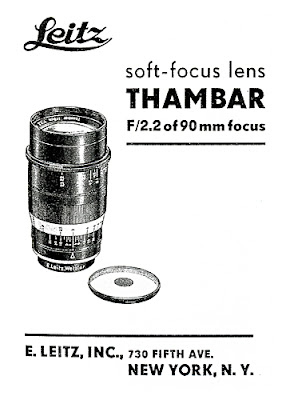THE LEGENDARY LEITZ THAMBAR
From the very beginning, Leica lenses
have always had a very high reputation for their sharpness and their special
tonal performance. This was a
prerequisite, demanded by Oskar Barnck and realized by Max Berek with even his
first lens designs for the Leica.
As a matter of fact, Leitz had been
criticized from time to time for not having any good portrait lenses. Many Leica users thought that the Leica
lenses were often too sharp for portrait work.
That gave the impetus for Max Berek to design the Leitz Thambar at the
beginning of the 1930s.

The Thambar was a soft focus lens,
displaying some rather unique characteristics, which made it one of the premier
portrait lenses of the time. The soft
focus effect was the result of the lens having been purposely designed with a
considerable amount of residual spherical aberration. The name Thambar was derived from Greek,
meaning “something that inspires wonder”, or wonderful. The lens was comprised of four elements, with
the two central elements cemented to form one group. A very similar formula was later chosen for
the 125mm Hektor for use on the Visoflex.

Leitz Thambar on a Leica IIIc with VIDOM
viewfinder
The spherical aberration of the lens was
produced primarily at the outer perimeter of the lens. Stopping it down to smaller apertures would
reduce this effect and it was totally eliminated at f/9. To further enhance the soft focus effect, the
lens came supplied with a special, clear filter that had a one centimeter
mirrored spot in the center which eliminated the sharp image created by the
center of the lens.

Element configuration of the Thambar
with installed filter on left

Leitz New York Thambar brochure
The maximum aperture of the lens was
f/2.2. This was reduced to f/2.3 with
the center spot filter in place. For
that reason the Thambar had two aperture scales, one in white for the f/stops
without the filter and one in red for the stops with the filter installed. The red scale went from f/2.3 to f/6.3
because above f/6.3 the filter became useless.
The maximum soft focus effect was obtained with the lens wide open and
with the filter installed. Stopping the
lens down would diminish this effect, thus giving the photographer full control
over the amount of soft focus.
Photographing with back lighting or lighting that produced flare would
further increase the soft focus effect.
The distance of the subject also had a significant effect on the
softness.
The Thambar actually was relatively
difficult to use because the rangefinder of the camera did not allow the soft
focus effect of the lens to be seen.
Subsequently a fair amount of experience was necessary to use the lens
effectively.
The production of the lens started on
1935 and ended in 1949. According to
company records, about 3000 lenses were produced. Today the Thambar is one of the most sought
after pieces by Leica collectors. Even
though a production of 3000 lenses is not all that rare, it is difficult to
find complete sets with the original filter, and sets complete with the filter
and the original red boxes are quite rare.
The Thambar is indeed a legendary piece of equipment among Leica
enthusiasts.
-------------------------------------------------------------------------------------------------------------------------------------------
Order: info@gmpphoto.com
Order: info@gmpphoto.com
Please make payment via PayPal to GMP Photography
Order: info@gmpphoto.com
Please make payment via PayPal to GMP
Photography
Click on ad to enlarge
Order: info@gmpphoto.com
Please make payment via PayPal to GMP
Photography
Click on ad to enlarge




Fascinating lens. They should make it again.
ReplyDeleteNot a bad idea. Especially with the current Leica M, for instance, using the Thambar would be a lot easier because of the live view capabilities.
DeleteIt is actually easier to use the Thambar with the rangefinder because the image is so soft in the EVF-2 of the Leica M240.
ReplyDeleteI don't know if a re-make of such a soft lens would make sense. It is very soft compared to todays lenses. A filter on the Noctilux or 90mm APO-Summicron would maybe make more sense.
But I guess ultimately, the lens designer of Leica, Peter Karbe would be the one who might have a vision for a "current Thambar" to obtain the sunshine qualities that they intended with the original Thambar.
I suggested the use of the EVF-2 since it allows to actually observe the amount of softness, depending on the aperture used and the use of the lens with or without the center spot filter. Using the standard viewfinder/rangefinder requires the user to be quite familiar with the use of the lens and its effects on the overall image.
DeleteI used to own a Thambar and I found that, when stopped down, it actually was fairly sharp, comparable to other 90mm lenses at the time.